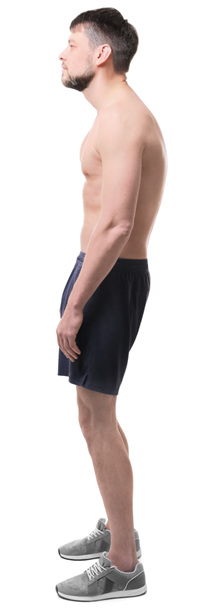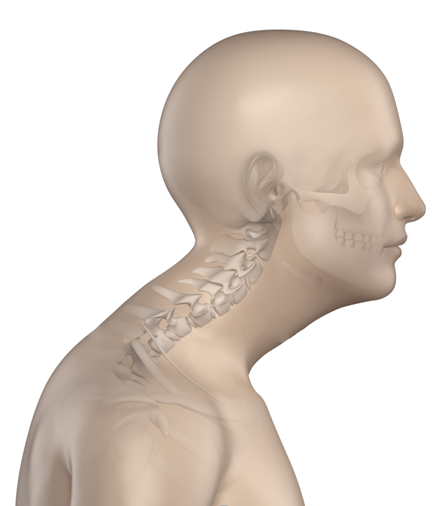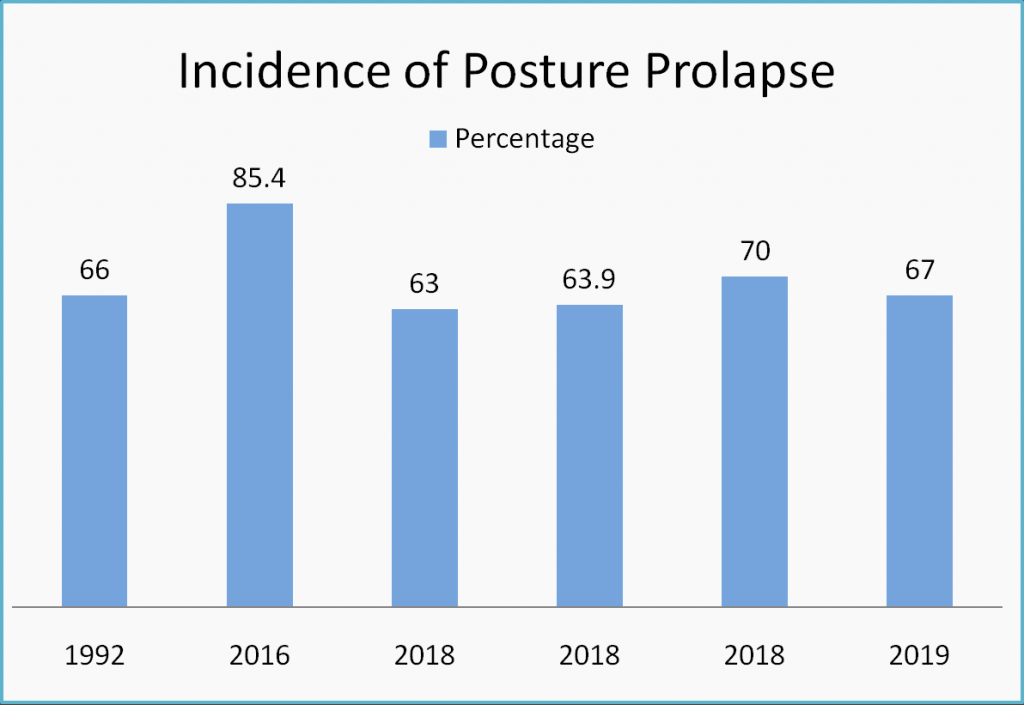Want look younger, thinner & more vibrant?
Then, you need to fix that posture!
Bad Posture Makes You Look Old (& Unhealthy)
Poor Posture is one of the top 5 signs of aging. [15] Everyone knows that poor posture looks awful. Women in ‘charm schools’ all across the US used to walk around with books on their head to train themselves to stand tall and look their best. It’s true that those with good posture instantly stand out in a crowd – it silently conveys strength, confidence and vitality. But, there’s so much more to posture than just looks.

Bad Posture Leads to Pain & Injury
People with Posture Prolapse:
Suffer more from aches & pains – You name it: back pain, neck pain, shoulder pain, TMJ – they’re all much more common in those with poor posture.[1,2]
Experience far more headaches: And the headaches they have are longer-lasting & more intense. [3]
Have been shown to be up to 18 TIMES more likely to suffer chronic neck pain.[4]
Are at a high risk of serious shoulder injury and have over 22 times greater incidence of Rotator Cuff Tears! [5]
Poor Posture Starves You Of Oxygen
As your head pushes out in front of your body, your structure becomes increasingly unstable. To deal with this instability, your body locks down the middle back in an attempt to increase stability. Unfortunately, because this is where your ribs attach, so they get locked down too. Impaired mobility of your thorax and ribs directly interferes with your ability to breath by preventing full inflation of the lungs. Severe Posture Prolapse has been shown to reduce lung capacity by as much as 1/3. To get an idea of what this feels like you’d have to climb to an elevation of 11,000 and experience how thin the air is up there – then imagine living with that – every day – even at sea level. [13,14]

Posture Prolapse Syndrome is the progressive deterioration and collapse of all the body’s secondary curves and a corresponding loss of the functionality that is associated with those curves.
The easiest way to spot Posture Prolapse Syndrome is by identifying a forward head position. Normally, the ear hole should be directly in line with the center point of the shoulder (when viewing the body from the side).
When the ear hole is pushed way out in front of the center point in the shoulder, that’s forward head position. This posture is the structural equivalent in humans to fin collapse in orcas.
Unfortunately, modern society is witnessing the deterioration of our physical structure on such a wide scale that forward head position has actually become the new “norm”. There are more people walking around these days with Posture Prolapse than there people with normal posture.
Dysfunctional Posture Is Far More Common Nowadays Than Normal Posture
Posture Prolapse is HUGE problem our society! The modern lifestyle is creating structural dysfunction on a very alarming scale. More than 2/3 of the population nowadays shows overt signs of Posture Prolapse and these numbers seem to be getting worse over time. [1,6,7,8,9,10]


Perhaps the worst part is, that because of the abundance of flexion-based activities incorporated into daily life nowadays, many children these days have this problem. These young people are developing in the first or second decade of life, structural problems that used to take adults 6 or 7 decades to develop.
Improved Posture Leads To Improved Mental Health
Studies have repeatedly found that the type of slumped posture seen with Posture Prolapse is associated with mild to moderate depressive symptoms. Multiple studies [11, 12,16] have shown that when these people with depression are trained into upright posture, they experience tremendous benefit including:
- Better Mood
- Increased Arousal
- More Confidence
- Less Fatigue
- Less Fear
- Less Anxiety
- Higher Self Esteem

References:
P Griegel-Morris , K Larson, K Mueller-Klaus, C A Oatis. Incidence of Common Postural Abnormalities in the Cervical, Shoulder, and Thoracic Regions and Their Association With Pain in Two Age Groups of Healthy Subjects. Phys Ther. 1992 Jun;72(6):425-31
Lee, WY, et al. – The relationship between FHP &tempromandibular Disorders. J. of Orofacial Pain. 1995
Trigger Points in the Suboccipital Muscles and Forward Head Posture in Tension-Type Headache. Headache: J. Head & Face Pain 2006 Mar; 46 (3): 454—460
McAviney J, Schulz D, Bock R, Harrison DE, Holland B. Determining the relationship between cervical lordosis and neck complaints. J Manipulative Physiol Ther. 2005 Mar-Apr;28(3):187-93.
Yamamoto et al. The impact of faulty posture on rotator cuff tears with and without symptoms. J. of Shoulder and Elbow Surgery 2015 Mar;24(3):446-52.
Vakili, Halabchi, & Z. Alizadeh. Prevalence of Common Postural Disorders Among Academic Dental Staff. Asian Journal of Sports Medicine 7(2) · July 2016
Verma et. al. Prevalence of forward head posture among 12-16 year old school going students – A cross sectional study. Applied Medical Research, 2018. Vol 4 (2)
Bashir, Naz & Noor. Prevalance of forward head posture among university students. Rawal Medical Journal 43(2):260-262 · April 2018
D. Anap & J.A. Mamania. Prevalence of Forward Head Posture amongst Physiotherapy Students: A Cross- sectional Study. International Journal of Education and Research in Health Sciences, October- December 2018;1(4):125-127
V. Ramalingam & S. Ambusam. Prevalence and Associated Risk Factors of Forward Head Posture among University Students. Indian Journal of Public Health Research and Development 10(7):775 · January 2019
Author links open overlay panelWilkes, C., Kydd, R., Sagar, M. & E.Broadbent. Upright posture improves affect and fatigue in people with depressive symptoms. Journal of Behavior Therapy and Experimental Psychiatry. Volume 54, March 2017, Pages 143-149
- S. Nair, M. Sagar , J. Sollers 3rd, N. Consedine , E. Broadbent. Do slumped and upright postures affect stress responses? A randomized trial. Health Psychol. 2015 Jun;34(6):632-41.
- Cathleen S. Colón-Emeric, MD, MHS, Heather E. Whitson, MD, MHS, Juliessa Pavon, MD, and Helen Hoenig, MD. Functional Decline in Older Adults Am Fam Physician. 2013 Sep 15; 88(6): 388–394.
- “Don’t Die of Altitude Sickness” https://www.highuintapackgoats.com/high-altitude-sickness–unpredictable-weather-in-mountainous-regions.htm
- Heather Hausenblas. Do We Look as Old as We Feel? Aging Perceptions of Gen X Adults. U.S.News & World Report•
- Ohio State University – https://www.sciencedaily.com/releases/2009/10/091005111627.htm
